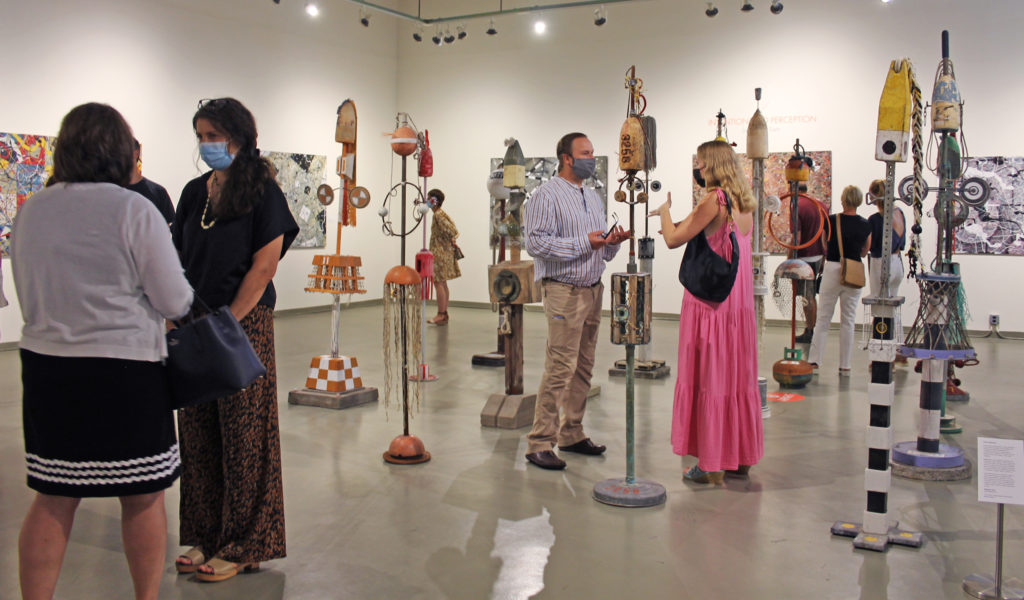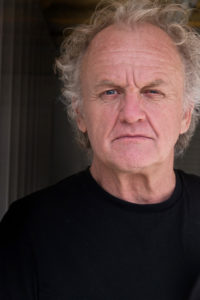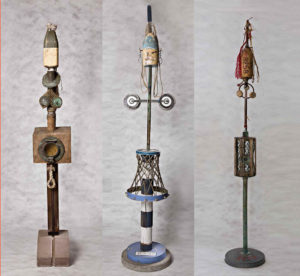Artist Stephen Datz creates vocabulary of found objects

The center of the main room of the Davis Family Gallery at the Schweinfurth Art Center is filled with a silent army of women, or Sirens, as Skaneateles artist Stephen Datz calls them. They are the product of a lifetime of beach combing on Martha’s Vineyard, the Caribbean island of Nevis, and marinas, fishing ports, and boat salvage yards.
“When we beach comb, we put ourselves in a different frame of mind from almost any other activity,” Datz said. “It’s like going to a nature-produced flea market where treasure is found, not paid for.”
He calls each item that he finds – a buoy, fishing net, odds and ends – a word in his art vocabulary. “The collection of vocabulary starts its own process of commonality of material, color, or shape and begins to form a sentence,” Datz said. “That sentence needs the assistance of forms I fabricate to become complete. From that point, they instruct me on how to finish them.”
Datz’s “Siren’s Song Series,” accompanied by dozens of his paintings, are on display in his exhibition, “Intention and Perception,” at the Schweinfurth Art Center in Auburn through Oct. 9.

The term siren harkens back to the story of the Greek King Odysseus, also known as Ulysses, who journeyed for 10 years to get home after the Trojan War. On his journey, his ship skirts around the island of the Sirens, dangerous creatures who use their enchanting voices to lure sailors to shipwreck.
“Yes, the Sirens of Ulysses drew mariners to their deaths with their song,” Datz said. “They are temptresses. The sculptures are the same, with bait, traps, nets, and lures.”
While each piece has a completion date, the sculptures aren’t necessarily finished. “I’m not sure if any of this process is complete,” he said. “Some vocabulary is 20 years old, and some I found yesterday. And if I found a ‘word’ tomorrow that was right for a 10-year-old Siren, I’ll use it.”
Many of Datz’s paintings fall into his “Mococo” series, which seeks to combine different aesthetics. “I was weaned on Modernism,” he said. “The paintings of the era covered the full spectrum of emotion with a non-representational freedom not seen before. Yet its advancement of aesthetics was similar to the Renaissance.
“The Renaissance was followed by Mannerism, Mannerism by the Baroque, and the Baroque by the Rococo, which was a bit like the Renaissance on steroids,” he continued. “In this series, my intention was focused on that progression, the intention to conglomerate two or more modernist artists, so Mococo.”
Many of his large paintings are filled with paint splatters reminiscent of Jackson Pollock work. But Datz sections off his paintings, often with black-and-white slats framing each part, giving it a more sculptural form. Many are untitled, but a couple have names. That is intentional.

“I do not title work to explain it to a viewer or to pose a riddle of any sort,” he said. “The work is nonverbal, so a worded title is not really necessary and can even be misleading or overly definitive to a purely visual intention. Occasionally, (a title) comes to mind that is so appropriate to a specific painting that it has to be used. In this show, ‘Pick Up Sticks’ and ‘Square Dance’ come to mind.”
Intention and Perception is on display at the Schweinfurth Art Center in Auburn through Oct. 9. Also on exhibit are In Person: A Group Exhibition with Works by John Fitzsimmons, Holly Greenberg, Lacey McKinney, and Donalee Peden Wesley and All Things Being Blue by Whitney Point artist Anna Warfield.
The Schweinfurth Art Center’s programs are made possible by the New York State Council on the Arts with the support of the Office of the Governor and the New York State Legislature.
